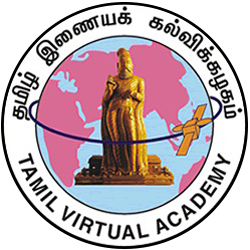Primary tabs
-
Lesson 3
d02133 Karanthai TinaiThis lesson discusses the various aspects of
'Karanthai Tinai'. It also examinesthe 13 'turais' or
steps pertaining to this 'tinai'. 'Karanthai tinai' lays
down the conduct or behaviour associated with
'karanthai ozhukkam ' or the act of reclaiming
the cattle captured by an enemy king. A king who
lost his cattle to the enemies was bound by duty to
wage a war and redeem them. This is the theme
underlying 'karanthai ozhukkam'. The 'karanthai
maravar' or soldiers wear the 'karanthai' flower when
they set out to reclaim the cattle seized by the
vetchi maravar. Hence, the name 'karanthai tinai'.
Tholkappiar did not classify 'karanthai ozhukkam' as
a separate 'tinai'. He probably saw it as a
complement of 'vetchi ozhukkam'. However, in 'Pura
Porul Venba Malai' 'karanthai ozhukkam' is set down
as a separate 'tinai'.There are 13 stages in 'karanthai ozhukkam' or
the process of overcoming the enemy and
recapturing the lost cattle.They are 'karanthai aravam',
'adaridai selavu', 'por malaithal', 'punnodu varuthal',
'porkalathu ozhithal', 'aaleri pillai', 'pillai thelivu',
'pillaiyattu', 'kaiyarunilai', 'nedumozhi kooral', 'pillai peyarchi', 'vetthiyal malibu' and 'kudinilai'. 'Karanthai Aravam'signifies the war cries and noises that arise
when the karanthai maravar or soldiers gather before
they set out for the battle. The soldiers follow the
route by which the vetchi soldiers safely herded
theraided cattle through the forest. This is called
'adaridai selavu'. The karanthai soldiers who follow
the footprints of the cattle confront the vetchi
soldiers and launch a fierce attack to redeem the
cattle. This is described in 'por malaithal'. 'Punnodu
varuthal' speaks of the triumphant return of the
karanthai soldiers to the great joy of their king.
The soldiers bear 'vizhuppun' or heroic wounds all
over their body and are proud of it. Hence, the
name 'punnodu varuthal' . 'Porkalathu ozhithal' laments
the heroic death of a karanthai warrior in the
course of the battle. 'Aaleri pillai' celebrates the
valour of the young 'karanthai' soldiers who
successfully overthrow their enemy. The 'karanthai'
soldier who is wounded in the battlefield is proud of
it and deems it a great honour. This realization
is described in 'pillai thelivu'. 'Pillaiyaattu' denotes
the 'koothu' or dance performed by a triumphant
'karanthai' soldier, who is likened to a child as he
knows no fear. The last 3 'tinais' describe certain
scenes from the battle field. The 'paanar' or the wandering minstrels lamenting the death of a
'karanthai' soldier who had patronized them is the
subject of 'kaiyarunilai'. A 'karanthai' soldier waxing
eloquent about his feats in the battlefield is called 'nedumozhi kooral'. Undaunted by the ill omen cast
by the 'pillai' or the 'kaarai' bird in the battle field, the karanthai warriors wage a fierce battle and win the
war. This is called 'pillai peyarchi'. The 'karanthai maravars' extolling the virtues of their king is the
theme of 'vetthiyal malibu'. Ancestry and lineage of
the karanthai king and maravars is also
celebrated. This is called 'kudinilai'.




